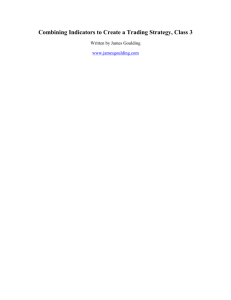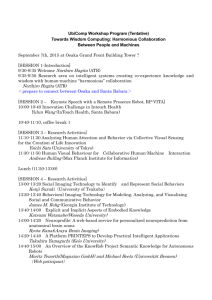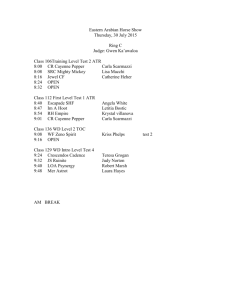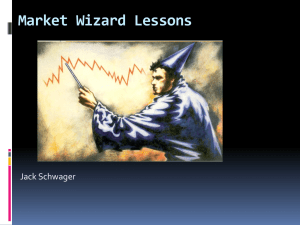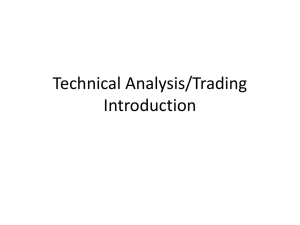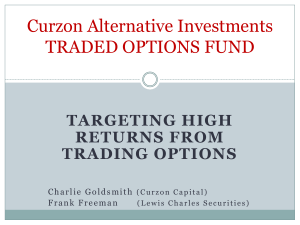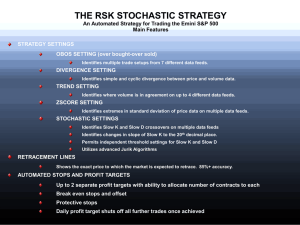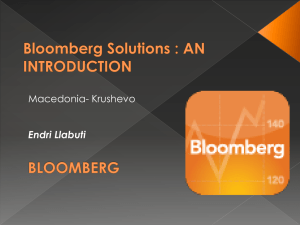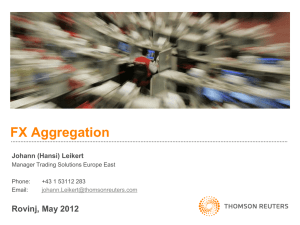eCbot Gold - JamesGoulding.com
advertisement
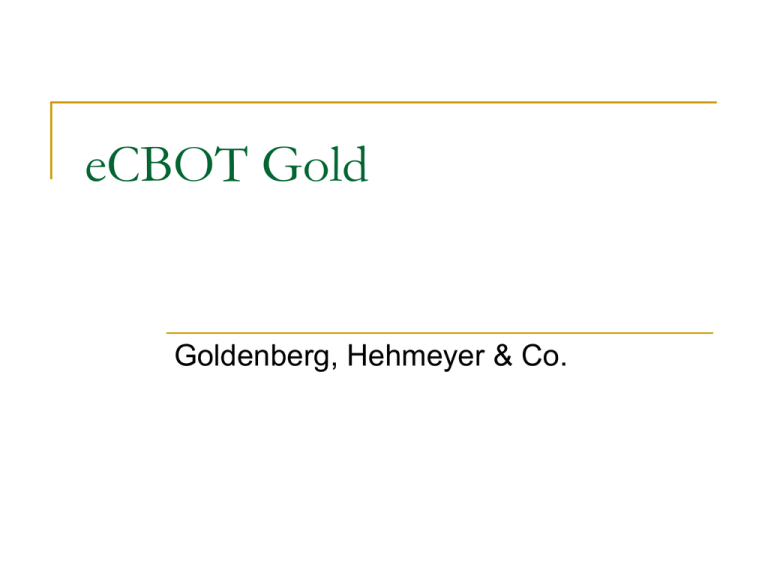
eCBOT Gold Goldenberg, Hehmeyer & Co. Contract Specifications Mini Gold Contract Size 33.2 fine troy oz. Deliverable Grades 33.2 fine troy ounces of gold, no less than 0.995 fine contained in no more than one bar. Variations in the quantity of the delivery unit shall not be in excess of 10% of 33.2 fine troy ounces. Tick Size 10 cent/fine troy ounce (or $3.32 per contract). Price Quote Dollars and cents/fine troy ounce. $10 a box Contract Months Jan, Feb, Mar, Apr, May, Jun, Jul, Aug, Sep, Oct, Nov, Dec Last Trading Day The business day immediately preceding the last two business days of the contract month. Last Delivery Day The last business day of the delivery month. Contract Specifications (cont.) Ticker Symbols YG Daily Price Limit NA Margins As of 06/26/06 Maintenance $830 Initial Margin Mark up % 135% Initial Margin $1,121 Trading Hours 6:16pm – 4:00pm CDT Gold is a Trader’s Product Gold is a trader's product as opposed to a hedgers product. To define what a trader's product is, simply divide the average daily volume by the monthly open interest. The quotient is a turn over ratio. Mini Gold Big Gold 1.2 1 0.8 The turn over ratio defines a trader's product from a hedger's product. Gold’s turn over ratio was 0.395 in May, which means it's turning over its open interest 3 time a day. That's a trader's product! 0.6 0.4 0.2 0 Jan Feb Mar Apr May Volume Average Daily Volume 41,008 45,000 40,000 35,000 30,000 23,159 25,000 20,000 Mini Gold 10,000 14,581 13,469 12,836 6,419 5,161 5,070 Jan Feb Mar 15,000 16,090 8,771 5,000 0 Apr May Big Gold Open Interest Open Interest 25,000 19,941 18,196 20,000 15,000 13,826 13,604 12,133 Mini Gold Big Gold 10,000 4,938 4,601 Jan Feb 5,000 5,416 6,359 3,870 0 Mar Apr May Trading When trading any new contract, that begins to gain interest, fundamental’s are pretty much out the window intra-day eCBOT mini-gold rarely trades fundamentals. That will change someday, but for now, I’m using technical indicators to guide me through the trading day. The following slides are some of the technical indicators I use during the trading day. 4 Questions I always answer 4 questions, entering a trade: Why am I getting in? (signal) Where am I getting in? (entry) Where’s my profit target? Where’s my stop loss? The 30 min chart (cont.) I will use candlesticks as a trend identification tool. For example, if the candle signal is bullish, I feel confident when I get long. I also use an RSI for overbought oversold signals. I wait for the RSI to reach 75/25, then, turn higher/lower on the close of the bar. When that happens, I buy/sell at the open of the next bar, using the ATR off of a 5 min chart as my stop (more on the ATR later). Answer Question #1 Why am I getting into the market? The candlestick pattern is bearish and the RSI closed over 75 then closed below 75. Both are bearish signals. The 30 min chart is my entry chart The 30 min chart (cont.) Answer Question #2 Where am I getting in? The next bar on the open (592.60) The 30 min chart (cont.) The 30 min chart (cont.) Answer Question #3 Where’s my profit target? Wish I could tell you something fancy but it’s a nobrainer. Every trader will get out where they can tolerate getting out. I felt good about the trade because S&Ps were struggling as was the EURUSD. So, I was looking for a $1 profit. Maybe more if I could tolerate it. The 30 min chart (cont.) What do I mean “I felt good about the trade because S&Ps were struggling and so was the EURUSD”? Correlation is the best indicator a trader can find. We are always looking for correlation between commodities, indexes, currencies etc. Gold is following the emini S&Ps and EURUSD. eCBOT emini Gold vs. emini S&Ps eCBOT emini Gold vs. EURUSD And…Gold vs. Silver The 30 min chart (cont.) Answer Question #4 Where’s my stop? I use the Average True Range (ATR) from a 5 min chart. I set the ATR to 10. The ATR is a volatility indicator that’s common in most charting packages. If ATR isn’t available I’ll use a plain volatility indicator, also set at 10. The ATR was at .90 at the time of the trade (cont). The 30 min chart (cont.) This means that the average true range over the last 10 trading bars (35 min) was 90 cents. My entry price was 592.60. Entry Price + ATR = Stop loss price 592.60 - .90 = 593.50 The 30 min chart (cont.) Put it all together So what really happened with the trade? Sold at 592.50 (but kept my stop at 592.60) Bought at 591.70 (couldn’t tolerate it!) Profit = .80 .80*$10 = $80 The 30 min chart; another trade Do I take all the RSI signals? No. The following page shows why. The 30 min chart (cont.) I didn’t take this trade. By the time we closed the RSI higher, after it had moved below the oversold line of 25, we had rallied $3 off the lows. Therefore, I concluded the trade was over. Chart Patterns in Gold Pennant Bullish signal . Let’s look at what happened on the next slide. Chart Patterns in Gold (cont.) The trade was to enter on the next bar’s open. However, we all know that sometimes it doesn’t work that nicely. Chart Patterns in Gold (cont.) Maybe you entered 2 bars prior to the break-out bar rather than the 10:15 bar. Your stop still would have kept you in the game. At the time the ATR on the 5 min was 1.20ish So, if you entered on the 9:45 bar at the open you’d have bought 579.10 worst case. Your stop was 579.00 – 1.20 = 577.80 The low of that bar was 587.10. Sure, you’d of sweated, but that’s trading.
